Management: Issues as a leader
VerifiedAdded on 2023/03/31
|10
|2636
|412
AI Summary
The residents of the town are facing trouble. The water supply in the city has been affected, and the residents are facing a problem using proper water supply concerning the recent eradication that has taken place. It is the sole responsibility of the organization and the leadership structure to help the citizens get adequate water supply.
Contribute Materials
Your contribution can guide someone’s learning journey. Share your
documents today.

Running head: MANAGEMENT 1
Management
Student’s Name
Institutional Affiliation
Management
Student’s Name
Institutional Affiliation
Secure Best Marks with AI Grader
Need help grading? Try our AI Grader for instant feedback on your assignments.

MANAGEMENT 2
Management
Issues as a leader
The residents of the town are facing trouble. The water supply in the city has been
affected, and the residents are facing a problem using proper water supply concerning the recent
eradication that has taken place. It is the sole responsibility of the organization and the leadership
structure to help the citizens get adequate water supply. It is the responsibility of the organization
to control the situation. However, the organization is facing leadership challenges that they have
to deal with. A leader, according to Mayfield, Mayfield, & Sharbrough (2015), is one that is
strong and not rude, one that is kind to their employees and not weak, one that is bold but not a
bully, one that is thoughtful but isn’t lazy. The leaders should embrace humility but not timid
(DuBois, Koch, Hanlon, Nyatuga, & Kerr, 2015). A good leader should be full of pride but not
arrogant. Lastly, the leader should have humor but without folly.
The central leadership and communication challenge facing the organization is an
internal challenge. The leadership structure of the organization has been exposed. Their
limitations are out there for everyone to see, especially the employees. The employees significant
on the personality weaknesses of their leaders and in turn fail the organization. Good leaders
should overcome their troubles by hiding their weakness or personality, something that the
organization has been unable to do (Ulmer, Sellnow, & Seeger, 2017).
The leadership disaster shows that the leaders and the management are not extremely
decisive. It is required that they consult with various people and make a decision (Men, & Jiang,
2016). A leader should be able to give direction and deadlines after consulting. He should be in a
position to request and demand more from his employees but not in a way that he frustrates them
(Raina, & Roebuck, 2016). In the case study, the leadership structure gives a lot of freedom so
Management
Issues as a leader
The residents of the town are facing trouble. The water supply in the city has been
affected, and the residents are facing a problem using proper water supply concerning the recent
eradication that has taken place. It is the sole responsibility of the organization and the leadership
structure to help the citizens get adequate water supply. It is the responsibility of the organization
to control the situation. However, the organization is facing leadership challenges that they have
to deal with. A leader, according to Mayfield, Mayfield, & Sharbrough (2015), is one that is
strong and not rude, one that is kind to their employees and not weak, one that is bold but not a
bully, one that is thoughtful but isn’t lazy. The leaders should embrace humility but not timid
(DuBois, Koch, Hanlon, Nyatuga, & Kerr, 2015). A good leader should be full of pride but not
arrogant. Lastly, the leader should have humor but without folly.
The central leadership and communication challenge facing the organization is an
internal challenge. The leadership structure of the organization has been exposed. Their
limitations are out there for everyone to see, especially the employees. The employees significant
on the personality weaknesses of their leaders and in turn fail the organization. Good leaders
should overcome their troubles by hiding their weakness or personality, something that the
organization has been unable to do (Ulmer, Sellnow, & Seeger, 2017).
The leadership disaster shows that the leaders and the management are not extremely
decisive. It is required that they consult with various people and make a decision (Men, & Jiang,
2016). A leader should be able to give direction and deadlines after consulting. He should be in a
position to request and demand more from his employees but not in a way that he frustrates them
(Raina, & Roebuck, 2016). In the case study, the leadership structure gives a lot of freedom so

MANAGEMENT 3
that each one of them is in a position to suggest where a meeting will take place. They disagree
all in unison, something that is not good for the organization and also not good for the people
waiting to receive regular services (Ford, Piccolo, & Ford, 2017). The organization cannot agree
on a favorite venue, time, and date to hold their meeting just because of the leadership cracks
that are caused due to laxity in personality.
Leadership styles appropriate for the case study
Smart leaders have something to learn from everyone and every situation. In this
situation, it is essential to apply two leadership styles that will help salvage the organization and
also help the people of the town (Harraf, Wanasika, Tate, & Talbott, 2015).
The first leadership style to apply in this situation is the autocratic management style.
Authoritarian management style is an extreme choice style of leadership, but at times, there is a
need to apply the same. The method is old fashioned and mostly used by the military, but it is
necessary.
In this situation, there are minimal levels of creativity needed. The people of the town
need an action to be taken almost immediately, considering that water supply is a matter of basic
need. The amount is required almost immediately. The project doesn’t require or need growth
facilitation and, therefore, there is a need to apply autocratic leadership (Hill, & Bartol, 2016).
Another important reason that makes autocratic leadership important is that with it comes
substantial planning, communication, and oversight cost. The town requires planning more than
anything else to get the supply back (Fernandez, & Rainey, 2017). The organization and the
chosen member require communication more than anything else. Communication within the
organization has to be enhanced, as seen in the meeting that has just been planned. Each of the
members of the group thinks they can suggest the way forward to meet, and some even directly
that each one of them is in a position to suggest where a meeting will take place. They disagree
all in unison, something that is not good for the organization and also not good for the people
waiting to receive regular services (Ford, Piccolo, & Ford, 2017). The organization cannot agree
on a favorite venue, time, and date to hold their meeting just because of the leadership cracks
that are caused due to laxity in personality.
Leadership styles appropriate for the case study
Smart leaders have something to learn from everyone and every situation. In this
situation, it is essential to apply two leadership styles that will help salvage the organization and
also help the people of the town (Harraf, Wanasika, Tate, & Talbott, 2015).
The first leadership style to apply in this situation is the autocratic management style.
Authoritarian management style is an extreme choice style of leadership, but at times, there is a
need to apply the same. The method is old fashioned and mostly used by the military, but it is
necessary.
In this situation, there are minimal levels of creativity needed. The people of the town
need an action to be taken almost immediately, considering that water supply is a matter of basic
need. The amount is required almost immediately. The project doesn’t require or need growth
facilitation and, therefore, there is a need to apply autocratic leadership (Hill, & Bartol, 2016).
Another important reason that makes autocratic leadership important is that with it comes
substantial planning, communication, and oversight cost. The town requires planning more than
anything else to get the supply back (Fernandez, & Rainey, 2017). The organization and the
chosen member require communication more than anything else. Communication within the
organization has to be enhanced, as seen in the meeting that has just been planned. Each of the
members of the group thinks they can suggest the way forward to meet, and some even directly
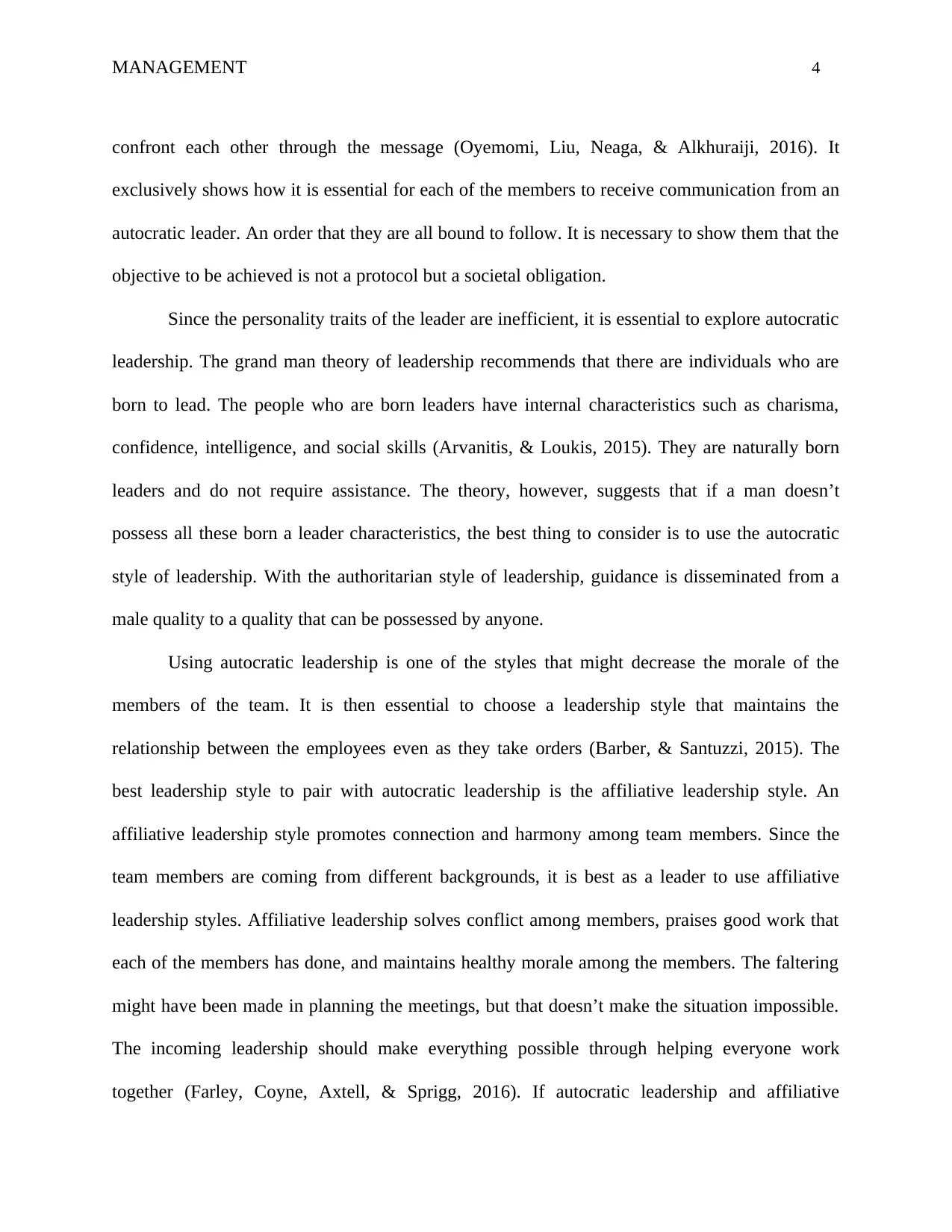
MANAGEMENT 4
confront each other through the message (Oyemomi, Liu, Neaga, & Alkhuraiji, 2016). It
exclusively shows how it is essential for each of the members to receive communication from an
autocratic leader. An order that they are all bound to follow. It is necessary to show them that the
objective to be achieved is not a protocol but a societal obligation.
Since the personality traits of the leader are inefficient, it is essential to explore autocratic
leadership. The grand man theory of leadership recommends that there are individuals who are
born to lead. The people who are born leaders have internal characteristics such as charisma,
confidence, intelligence, and social skills (Arvanitis, & Loukis, 2015). They are naturally born
leaders and do not require assistance. The theory, however, suggests that if a man doesn’t
possess all these born a leader characteristics, the best thing to consider is to use the autocratic
style of leadership. With the authoritarian style of leadership, guidance is disseminated from a
male quality to a quality that can be possessed by anyone.
Using autocratic leadership is one of the styles that might decrease the morale of the
members of the team. It is then essential to choose a leadership style that maintains the
relationship between the employees even as they take orders (Barber, & Santuzzi, 2015). The
best leadership style to pair with autocratic leadership is the affiliative leadership style. An
affiliative leadership style promotes connection and harmony among team members. Since the
team members are coming from different backgrounds, it is best as a leader to use affiliative
leadership styles. Affiliative leadership solves conflict among members, praises good work that
each of the members has done, and maintains healthy morale among the members. The faltering
might have been made in planning the meetings, but that doesn’t make the situation impossible.
The incoming leadership should make everything possible through helping everyone work
together (Farley, Coyne, Axtell, & Sprigg, 2016). If autocratic leadership and affiliative
confront each other through the message (Oyemomi, Liu, Neaga, & Alkhuraiji, 2016). It
exclusively shows how it is essential for each of the members to receive communication from an
autocratic leader. An order that they are all bound to follow. It is necessary to show them that the
objective to be achieved is not a protocol but a societal obligation.
Since the personality traits of the leader are inefficient, it is essential to explore autocratic
leadership. The grand man theory of leadership recommends that there are individuals who are
born to lead. The people who are born leaders have internal characteristics such as charisma,
confidence, intelligence, and social skills (Arvanitis, & Loukis, 2015). They are naturally born
leaders and do not require assistance. The theory, however, suggests that if a man doesn’t
possess all these born a leader characteristics, the best thing to consider is to use the autocratic
style of leadership. With the authoritarian style of leadership, guidance is disseminated from a
male quality to a quality that can be possessed by anyone.
Using autocratic leadership is one of the styles that might decrease the morale of the
members of the team. It is then essential to choose a leadership style that maintains the
relationship between the employees even as they take orders (Barber, & Santuzzi, 2015). The
best leadership style to pair with autocratic leadership is the affiliative leadership style. An
affiliative leadership style promotes connection and harmony among team members. Since the
team members are coming from different backgrounds, it is best as a leader to use affiliative
leadership styles. Affiliative leadership solves conflict among members, praises good work that
each of the members has done, and maintains healthy morale among the members. The faltering
might have been made in planning the meetings, but that doesn’t make the situation impossible.
The incoming leadership should make everything possible through helping everyone work
together (Farley, Coyne, Axtell, & Sprigg, 2016). If autocratic leadership and affiliative
Paraphrase This Document
Need a fresh take? Get an instant paraphrase of this document with our AI Paraphraser
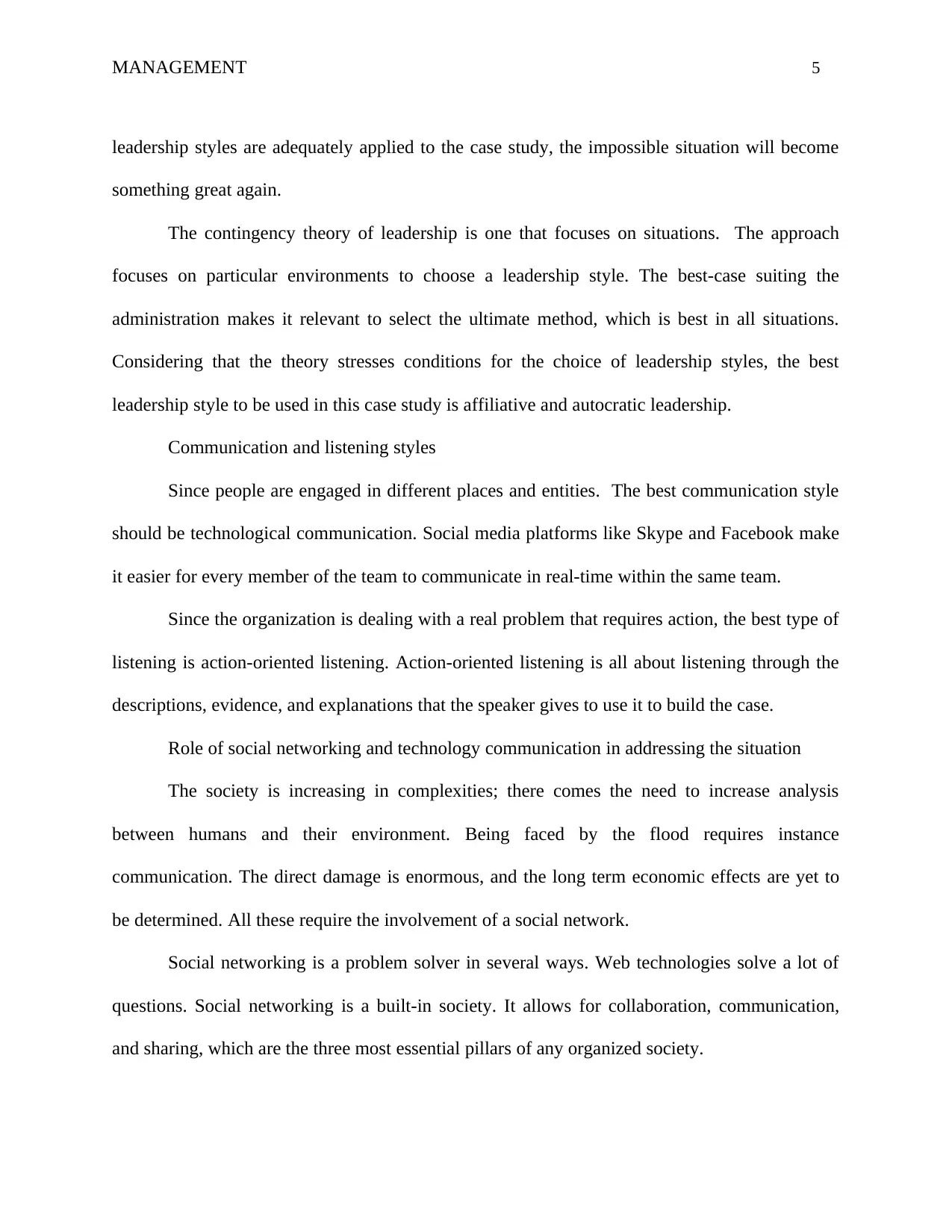
MANAGEMENT 5
leadership styles are adequately applied to the case study, the impossible situation will become
something great again.
The contingency theory of leadership is one that focuses on situations. The approach
focuses on particular environments to choose a leadership style. The best-case suiting the
administration makes it relevant to select the ultimate method, which is best in all situations.
Considering that the theory stresses conditions for the choice of leadership styles, the best
leadership style to be used in this case study is affiliative and autocratic leadership.
Communication and listening styles
Since people are engaged in different places and entities. The best communication style
should be technological communication. Social media platforms like Skype and Facebook make
it easier for every member of the team to communicate in real-time within the same team.
Since the organization is dealing with a real problem that requires action, the best type of
listening is action-oriented listening. Action-oriented listening is all about listening through the
descriptions, evidence, and explanations that the speaker gives to use it to build the case.
Role of social networking and technology communication in addressing the situation
The society is increasing in complexities; there comes the need to increase analysis
between humans and their environment. Being faced by the flood requires instance
communication. The direct damage is enormous, and the long term economic effects are yet to
be determined. All these require the involvement of a social network.
Social networking is a problem solver in several ways. Web technologies solve a lot of
questions. Social networking is a built-in society. It allows for collaboration, communication,
and sharing, which are the three most essential pillars of any organized society.
leadership styles are adequately applied to the case study, the impossible situation will become
something great again.
The contingency theory of leadership is one that focuses on situations. The approach
focuses on particular environments to choose a leadership style. The best-case suiting the
administration makes it relevant to select the ultimate method, which is best in all situations.
Considering that the theory stresses conditions for the choice of leadership styles, the best
leadership style to be used in this case study is affiliative and autocratic leadership.
Communication and listening styles
Since people are engaged in different places and entities. The best communication style
should be technological communication. Social media platforms like Skype and Facebook make
it easier for every member of the team to communicate in real-time within the same team.
Since the organization is dealing with a real problem that requires action, the best type of
listening is action-oriented listening. Action-oriented listening is all about listening through the
descriptions, evidence, and explanations that the speaker gives to use it to build the case.
Role of social networking and technology communication in addressing the situation
The society is increasing in complexities; there comes the need to increase analysis
between humans and their environment. Being faced by the flood requires instance
communication. The direct damage is enormous, and the long term economic effects are yet to
be determined. All these require the involvement of a social network.
Social networking is a problem solver in several ways. Web technologies solve a lot of
questions. Social networking is a built-in society. It allows for collaboration, communication,
and sharing, which are the three most essential pillars of any organized society.
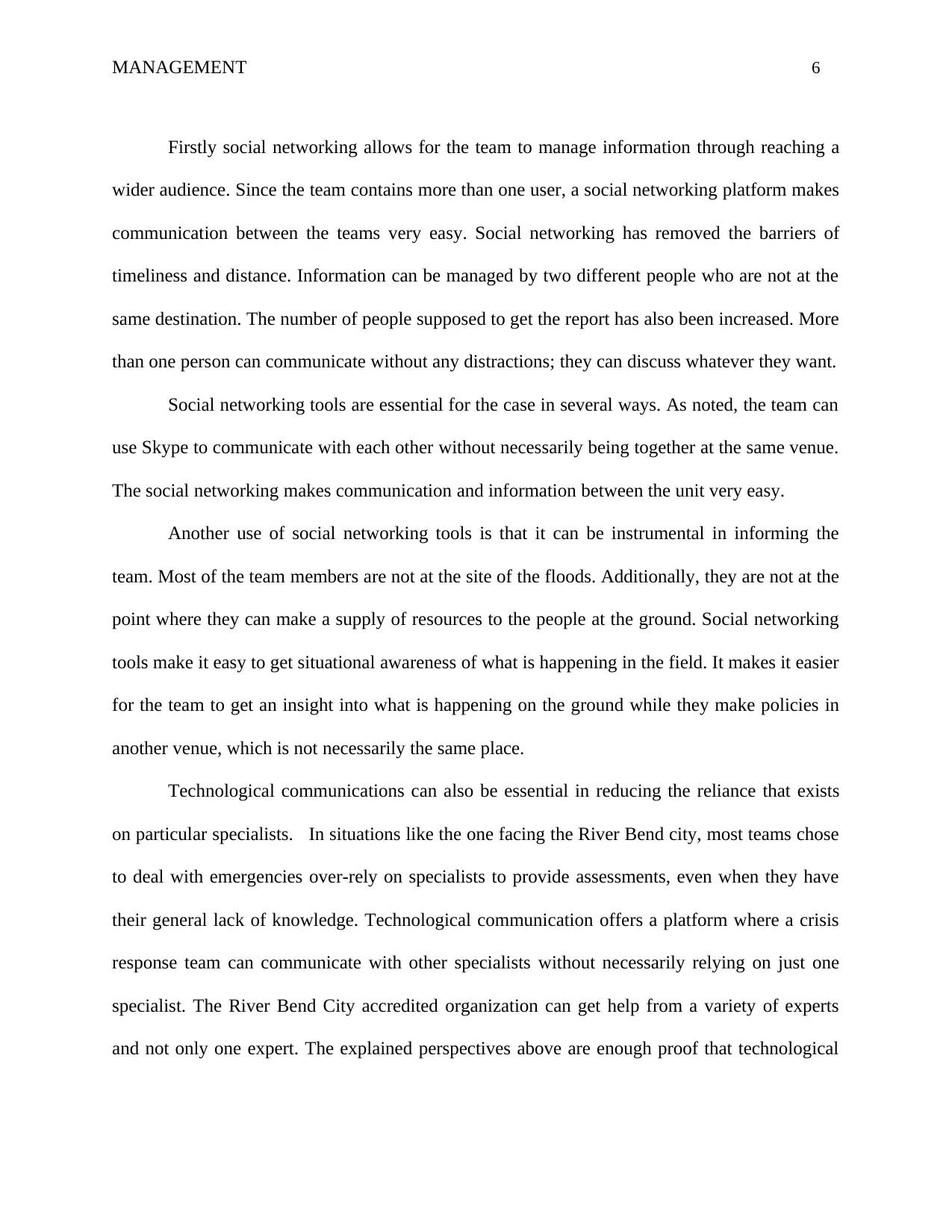
MANAGEMENT 6
Firstly social networking allows for the team to manage information through reaching a
wider audience. Since the team contains more than one user, a social networking platform makes
communication between the teams very easy. Social networking has removed the barriers of
timeliness and distance. Information can be managed by two different people who are not at the
same destination. The number of people supposed to get the report has also been increased. More
than one person can communicate without any distractions; they can discuss whatever they want.
Social networking tools are essential for the case in several ways. As noted, the team can
use Skype to communicate with each other without necessarily being together at the same venue.
The social networking makes communication and information between the unit very easy.
Another use of social networking tools is that it can be instrumental in informing the
team. Most of the team members are not at the site of the floods. Additionally, they are not at the
point where they can make a supply of resources to the people at the ground. Social networking
tools make it easy to get situational awareness of what is happening in the field. It makes it easier
for the team to get an insight into what is happening on the ground while they make policies in
another venue, which is not necessarily the same place.
Technological communications can also be essential in reducing the reliance that exists
on particular specialists. In situations like the one facing the River Bend city, most teams chose
to deal with emergencies over-rely on specialists to provide assessments, even when they have
their general lack of knowledge. Technological communication offers a platform where a crisis
response team can communicate with other specialists without necessarily relying on just one
specialist. The River Bend City accredited organization can get help from a variety of experts
and not only one expert. The explained perspectives above are enough proof that technological
Firstly social networking allows for the team to manage information through reaching a
wider audience. Since the team contains more than one user, a social networking platform makes
communication between the teams very easy. Social networking has removed the barriers of
timeliness and distance. Information can be managed by two different people who are not at the
same destination. The number of people supposed to get the report has also been increased. More
than one person can communicate without any distractions; they can discuss whatever they want.
Social networking tools are essential for the case in several ways. As noted, the team can
use Skype to communicate with each other without necessarily being together at the same venue.
The social networking makes communication and information between the unit very easy.
Another use of social networking tools is that it can be instrumental in informing the
team. Most of the team members are not at the site of the floods. Additionally, they are not at the
point where they can make a supply of resources to the people at the ground. Social networking
tools make it easy to get situational awareness of what is happening in the field. It makes it easier
for the team to get an insight into what is happening on the ground while they make policies in
another venue, which is not necessarily the same place.
Technological communications can also be essential in reducing the reliance that exists
on particular specialists. In situations like the one facing the River Bend city, most teams chose
to deal with emergencies over-rely on specialists to provide assessments, even when they have
their general lack of knowledge. Technological communication offers a platform where a crisis
response team can communicate with other specialists without necessarily relying on just one
specialist. The River Bend City accredited organization can get help from a variety of experts
and not only one expert. The explained perspectives above are enough proof that technological
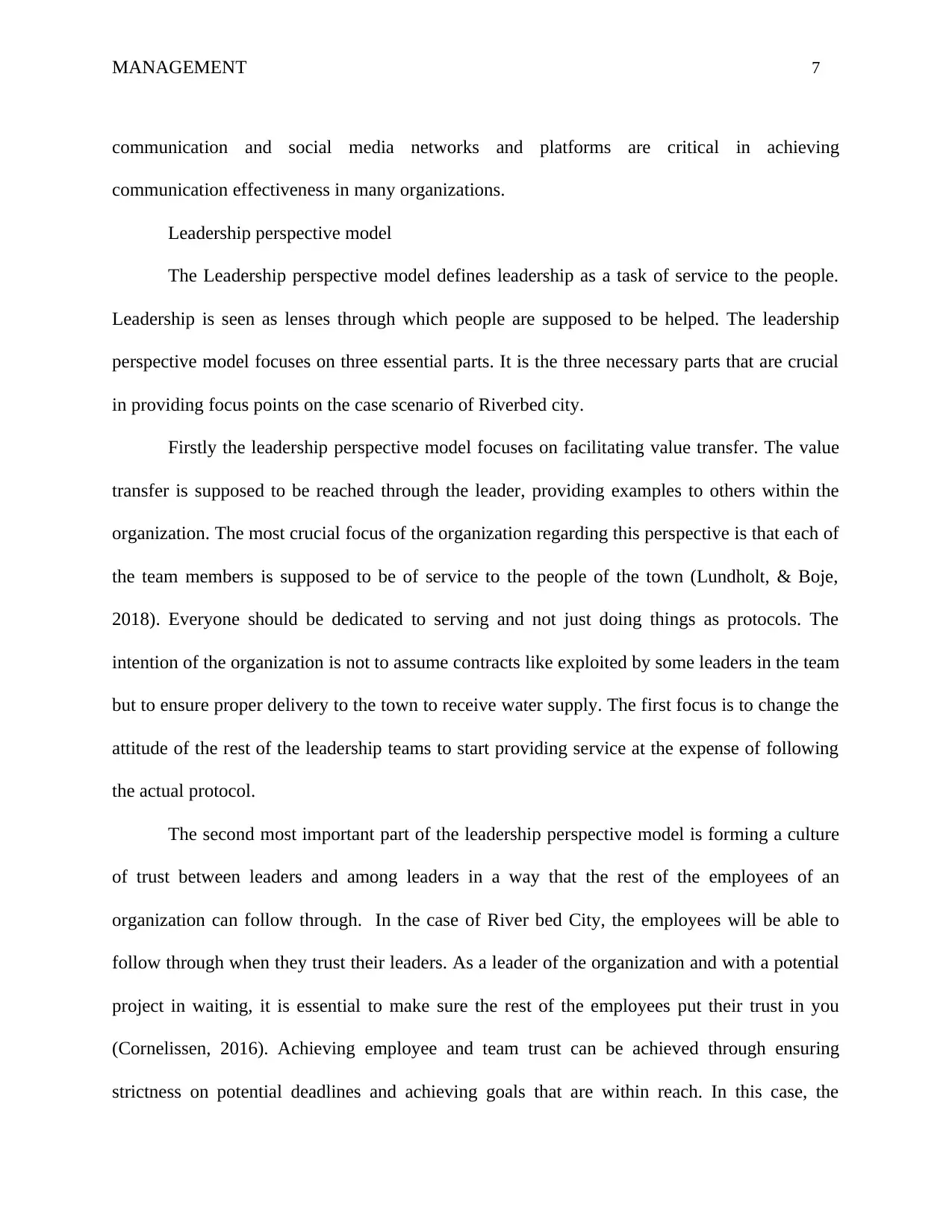
MANAGEMENT 7
communication and social media networks and platforms are critical in achieving
communication effectiveness in many organizations.
Leadership perspective model
The Leadership perspective model defines leadership as a task of service to the people.
Leadership is seen as lenses through which people are supposed to be helped. The leadership
perspective model focuses on three essential parts. It is the three necessary parts that are crucial
in providing focus points on the case scenario of Riverbed city.
Firstly the leadership perspective model focuses on facilitating value transfer. The value
transfer is supposed to be reached through the leader, providing examples to others within the
organization. The most crucial focus of the organization regarding this perspective is that each of
the team members is supposed to be of service to the people of the town (Lundholt, & Boje,
2018). Everyone should be dedicated to serving and not just doing things as protocols. The
intention of the organization is not to assume contracts like exploited by some leaders in the team
but to ensure proper delivery to the town to receive water supply. The first focus is to change the
attitude of the rest of the leadership teams to start providing service at the expense of following
the actual protocol.
The second most important part of the leadership perspective model is forming a culture
of trust between leaders and among leaders in a way that the rest of the employees of an
organization can follow through. In the case of River bed City, the employees will be able to
follow through when they trust their leaders. As a leader of the organization and with a potential
project in waiting, it is essential to make sure the rest of the employees put their trust in you
(Cornelissen, 2016). Achieving employee and team trust can be achieved through ensuring
strictness on potential deadlines and achieving goals that are within reach. In this case, the
communication and social media networks and platforms are critical in achieving
communication effectiveness in many organizations.
Leadership perspective model
The Leadership perspective model defines leadership as a task of service to the people.
Leadership is seen as lenses through which people are supposed to be helped. The leadership
perspective model focuses on three essential parts. It is the three necessary parts that are crucial
in providing focus points on the case scenario of Riverbed city.
Firstly the leadership perspective model focuses on facilitating value transfer. The value
transfer is supposed to be reached through the leader, providing examples to others within the
organization. The most crucial focus of the organization regarding this perspective is that each of
the team members is supposed to be of service to the people of the town (Lundholt, & Boje,
2018). Everyone should be dedicated to serving and not just doing things as protocols. The
intention of the organization is not to assume contracts like exploited by some leaders in the team
but to ensure proper delivery to the town to receive water supply. The first focus is to change the
attitude of the rest of the leadership teams to start providing service at the expense of following
the actual protocol.
The second most important part of the leadership perspective model is forming a culture
of trust between leaders and among leaders in a way that the rest of the employees of an
organization can follow through. In the case of River bed City, the employees will be able to
follow through when they trust their leaders. As a leader of the organization and with a potential
project in waiting, it is essential to make sure the rest of the employees put their trust in you
(Cornelissen, 2016). Achieving employee and team trust can be achieved through ensuring
strictness on potential deadlines and achieving goals that are within reach. In this case, the
Secure Best Marks with AI Grader
Need help grading? Try our AI Grader for instant feedback on your assignments.
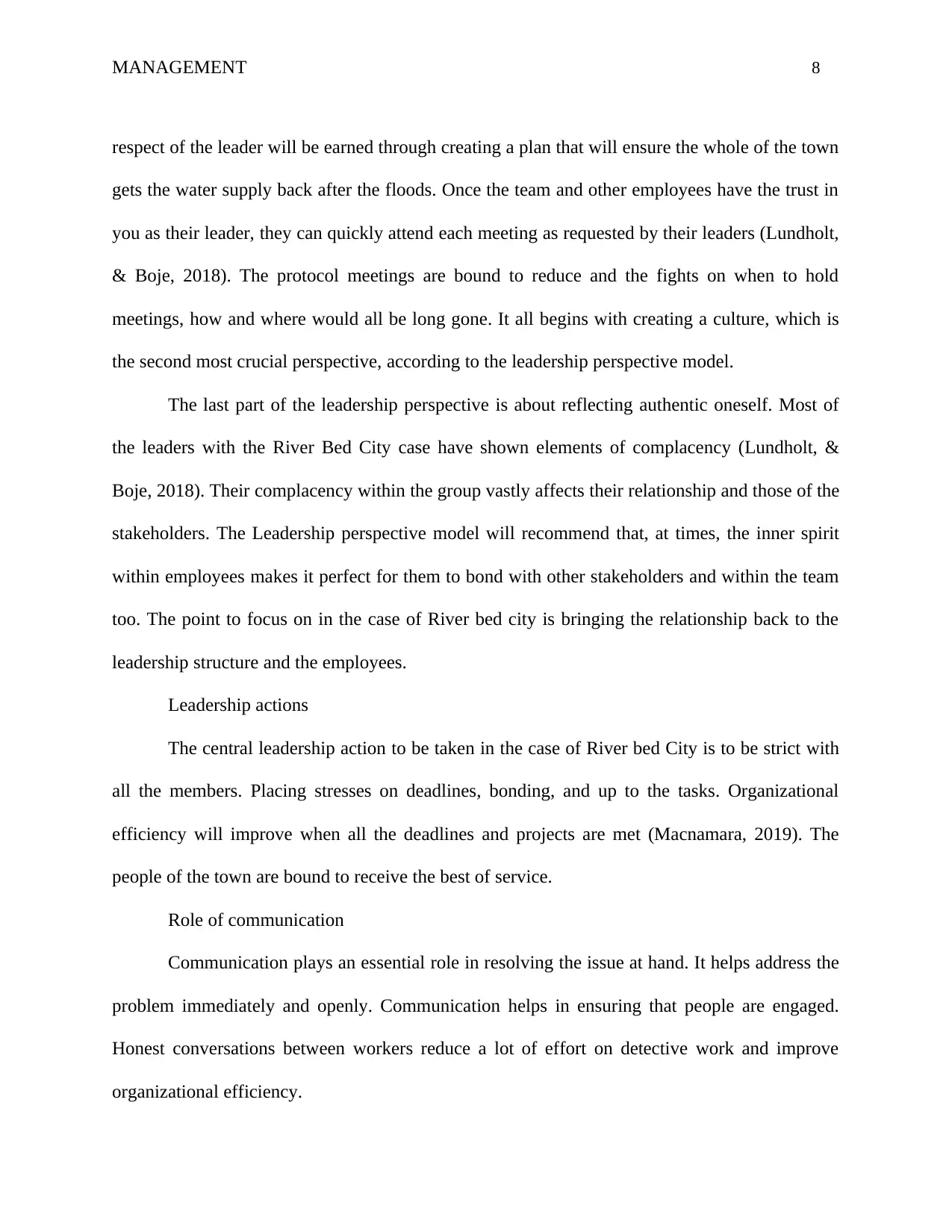
MANAGEMENT 8
respect of the leader will be earned through creating a plan that will ensure the whole of the town
gets the water supply back after the floods. Once the team and other employees have the trust in
you as their leader, they can quickly attend each meeting as requested by their leaders (Lundholt,
& Boje, 2018). The protocol meetings are bound to reduce and the fights on when to hold
meetings, how and where would all be long gone. It all begins with creating a culture, which is
the second most crucial perspective, according to the leadership perspective model.
The last part of the leadership perspective is about reflecting authentic oneself. Most of
the leaders with the River Bed City case have shown elements of complacency (Lundholt, &
Boje, 2018). Their complacency within the group vastly affects their relationship and those of the
stakeholders. The Leadership perspective model will recommend that, at times, the inner spirit
within employees makes it perfect for them to bond with other stakeholders and within the team
too. The point to focus on in the case of River bed city is bringing the relationship back to the
leadership structure and the employees.
Leadership actions
The central leadership action to be taken in the case of River bed City is to be strict with
all the members. Placing stresses on deadlines, bonding, and up to the tasks. Organizational
efficiency will improve when all the deadlines and projects are met (Macnamara, 2019). The
people of the town are bound to receive the best of service.
Role of communication
Communication plays an essential role in resolving the issue at hand. It helps address the
problem immediately and openly. Communication helps in ensuring that people are engaged.
Honest conversations between workers reduce a lot of effort on detective work and improve
organizational efficiency.
respect of the leader will be earned through creating a plan that will ensure the whole of the town
gets the water supply back after the floods. Once the team and other employees have the trust in
you as their leader, they can quickly attend each meeting as requested by their leaders (Lundholt,
& Boje, 2018). The protocol meetings are bound to reduce and the fights on when to hold
meetings, how and where would all be long gone. It all begins with creating a culture, which is
the second most crucial perspective, according to the leadership perspective model.
The last part of the leadership perspective is about reflecting authentic oneself. Most of
the leaders with the River Bed City case have shown elements of complacency (Lundholt, &
Boje, 2018). Their complacency within the group vastly affects their relationship and those of the
stakeholders. The Leadership perspective model will recommend that, at times, the inner spirit
within employees makes it perfect for them to bond with other stakeholders and within the team
too. The point to focus on in the case of River bed city is bringing the relationship back to the
leadership structure and the employees.
Leadership actions
The central leadership action to be taken in the case of River bed City is to be strict with
all the members. Placing stresses on deadlines, bonding, and up to the tasks. Organizational
efficiency will improve when all the deadlines and projects are met (Macnamara, 2019). The
people of the town are bound to receive the best of service.
Role of communication
Communication plays an essential role in resolving the issue at hand. It helps address the
problem immediately and openly. Communication helps in ensuring that people are engaged.
Honest conversations between workers reduce a lot of effort on detective work and improve
organizational efficiency.
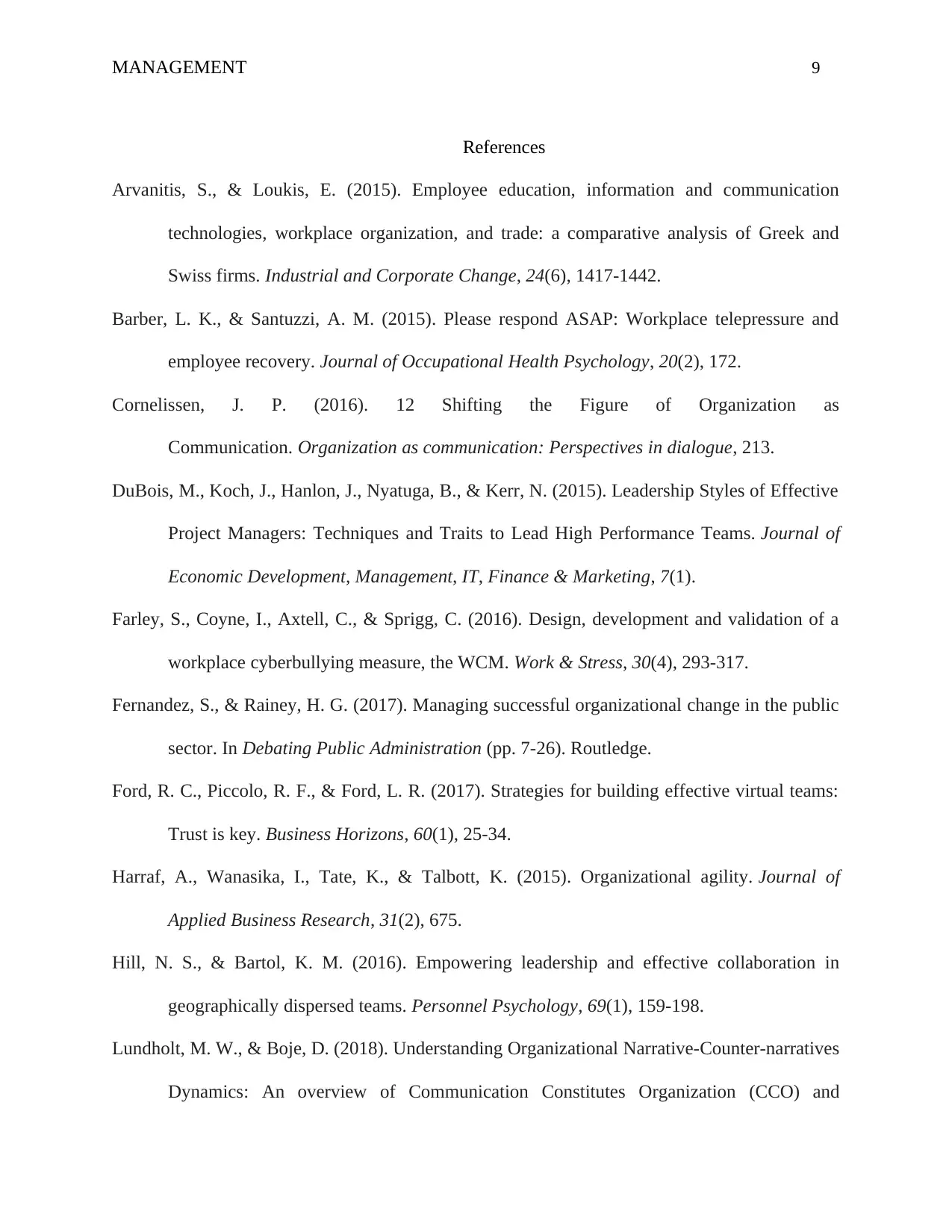
MANAGEMENT 9
References
Arvanitis, S., & Loukis, E. (2015). Employee education, information and communication
technologies, workplace organization, and trade: a comparative analysis of Greek and
Swiss firms. Industrial and Corporate Change, 24(6), 1417-1442.
Barber, L. K., & Santuzzi, A. M. (2015). Please respond ASAP: Workplace telepressure and
employee recovery. Journal of Occupational Health Psychology, 20(2), 172.
Cornelissen, J. P. (2016). 12 Shifting the Figure of Organization as
Communication. Organization as communication: Perspectives in dialogue, 213.
DuBois, M., Koch, J., Hanlon, J., Nyatuga, B., & Kerr, N. (2015). Leadership Styles of Effective
Project Managers: Techniques and Traits to Lead High Performance Teams. Journal of
Economic Development, Management, IT, Finance & Marketing, 7(1).
Farley, S., Coyne, I., Axtell, C., & Sprigg, C. (2016). Design, development and validation of a
workplace cyberbullying measure, the WCM. Work & Stress, 30(4), 293-317.
Fernandez, S., & Rainey, H. G. (2017). Managing successful organizational change in the public
sector. In Debating Public Administration (pp. 7-26). Routledge.
Ford, R. C., Piccolo, R. F., & Ford, L. R. (2017). Strategies for building effective virtual teams:
Trust is key. Business Horizons, 60(1), 25-34.
Harraf, A., Wanasika, I., Tate, K., & Talbott, K. (2015). Organizational agility. Journal of
Applied Business Research, 31(2), 675.
Hill, N. S., & Bartol, K. M. (2016). Empowering leadership and effective collaboration in
geographically dispersed teams. Personnel Psychology, 69(1), 159-198.
Lundholt, M. W., & Boje, D. (2018). Understanding Organizational Narrative-Counter-narratives
Dynamics: An overview of Communication Constitutes Organization (CCO) and
References
Arvanitis, S., & Loukis, E. (2015). Employee education, information and communication
technologies, workplace organization, and trade: a comparative analysis of Greek and
Swiss firms. Industrial and Corporate Change, 24(6), 1417-1442.
Barber, L. K., & Santuzzi, A. M. (2015). Please respond ASAP: Workplace telepressure and
employee recovery. Journal of Occupational Health Psychology, 20(2), 172.
Cornelissen, J. P. (2016). 12 Shifting the Figure of Organization as
Communication. Organization as communication: Perspectives in dialogue, 213.
DuBois, M., Koch, J., Hanlon, J., Nyatuga, B., & Kerr, N. (2015). Leadership Styles of Effective
Project Managers: Techniques and Traits to Lead High Performance Teams. Journal of
Economic Development, Management, IT, Finance & Marketing, 7(1).
Farley, S., Coyne, I., Axtell, C., & Sprigg, C. (2016). Design, development and validation of a
workplace cyberbullying measure, the WCM. Work & Stress, 30(4), 293-317.
Fernandez, S., & Rainey, H. G. (2017). Managing successful organizational change in the public
sector. In Debating Public Administration (pp. 7-26). Routledge.
Ford, R. C., Piccolo, R. F., & Ford, L. R. (2017). Strategies for building effective virtual teams:
Trust is key. Business Horizons, 60(1), 25-34.
Harraf, A., Wanasika, I., Tate, K., & Talbott, K. (2015). Organizational agility. Journal of
Applied Business Research, 31(2), 675.
Hill, N. S., & Bartol, K. M. (2016). Empowering leadership and effective collaboration in
geographically dispersed teams. Personnel Psychology, 69(1), 159-198.
Lundholt, M. W., & Boje, D. (2018). Understanding Organizational Narrative-Counter-narratives
Dynamics: An overview of Communication Constitutes Organization (CCO) and

MANAGEMENT 10
Storytelling Organization Theory (SOT) approaches. Communication and Language at
Work, 5(1), 18-29.
Macnamara, J. (2019). Explicating Listening in Organization–Public Communication: Theory,
Practices, Technologies. International Journal of Communication, 13, 22.
Mayfield, J., Mayfield, M., & Sharbrough III, W. C. (2015). Strategic vision and values in top
leaders’ communications: Motivating language at a higher level. International Journal of
Business Communication, 52(1), 97-121.
Men, L. R., & Jiang, H. (2016). Cultivating quality employee-organization relationships: The
interplay among organizational leadership, culture, and communication. International
Journal of Strategic Communication, 10(5), 462-479.
Oyemomi, O., Liu, S., Neaga, I., & Alkhuraiji, A. (2016). How knowledge sharing and business
process contribute to organizational performance: Using the fsQCA approach. Journal of
Business Research, 69(11), 5222-5227.
Raina, R., & Roebuck, D. B. (2016). Exploring cultural influence on managerial communication
in relationship to job satisfaction, organizational commitment, and the employees’
propensity to leave in the insurance sector of India. International Journal of Business
Communication, 53(1), 97-130.
Ulmer, R. R., Sellnow, T. L., & Seeger, M. W. (2017). Effective crisis communication: Moving
from crisis to opportunity. Sage Publications.
Storytelling Organization Theory (SOT) approaches. Communication and Language at
Work, 5(1), 18-29.
Macnamara, J. (2019). Explicating Listening in Organization–Public Communication: Theory,
Practices, Technologies. International Journal of Communication, 13, 22.
Mayfield, J., Mayfield, M., & Sharbrough III, W. C. (2015). Strategic vision and values in top
leaders’ communications: Motivating language at a higher level. International Journal of
Business Communication, 52(1), 97-121.
Men, L. R., & Jiang, H. (2016). Cultivating quality employee-organization relationships: The
interplay among organizational leadership, culture, and communication. International
Journal of Strategic Communication, 10(5), 462-479.
Oyemomi, O., Liu, S., Neaga, I., & Alkhuraiji, A. (2016). How knowledge sharing and business
process contribute to organizational performance: Using the fsQCA approach. Journal of
Business Research, 69(11), 5222-5227.
Raina, R., & Roebuck, D. B. (2016). Exploring cultural influence on managerial communication
in relationship to job satisfaction, organizational commitment, and the employees’
propensity to leave in the insurance sector of India. International Journal of Business
Communication, 53(1), 97-130.
Ulmer, R. R., Sellnow, T. L., & Seeger, M. W. (2017). Effective crisis communication: Moving
from crisis to opportunity. Sage Publications.
1 out of 10
![[object Object]](/_next/static/media/star-bottom.7253800d.svg)





